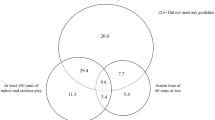Abstract
The primary purpose of the present study was to examine adherence to current active play and electronic media use guidelines in a sample of US preschool-aged children and to examine whether differences occurred across gender and parental education. 164 parents completed an on-line survey to estimate preschool children’s active play and sedentary behaviors. For weekdays, 50% of the sample met the active play guideline with this increasing to 65% during the weekend. With respect to electronic media use, 90% of the sample met guidelines during the week, with the percentage meeting guidelines dropping to 78% during the weekend. A greater percentage of preschool children from high parental education families (83.4 ± 3.3) met electronic media use guidelines on the weekends, compared to preschool children from low parental education families (59.4 ± 8.1) (p = 0.002). Our findings indicate that a substantial portion of preschool children are not meeting active play guidelines and that adherence to active play and electronic media use guidelines may be influenced by parental education.
Similar content being viewed by others
References
Li, K., Cardinal, B. J., & Settersten, R, Jr. (2009). A life-course perspective on physical activity promotion: Applications and implications. Quest, 61, 336–352.
Ginsburg, K. R. (2007). The importance of play in promoting healthy child development and maintaining strong parent–child bonds. Pediatrics, 119, 182–191.
Hancox, R. J., Milne, B. J., & Poulton, R. (2004). Association between child and adolescent television viewing and adult health: A longitudinal birth cohort study. Lancet, 364, 257–262.
Moore, L. L., Gao, D., Bradlee, M. L., et al. (2003). Does early physical activity predict body fat change throughout childhood? Preventive Medicine, 37, 10–17.
Telama, R., Yang, X., Laakso, L., & Viikari, J. (1997). Physical activity in childhood and adolescence as predictor of physical activity in young adulthood. American Journal of Preventative Medicine, 13, 317–323.
Telama, R. (2009). Tracking activity from childhood to adulthood: A review. Obesity Facts, 2, 187–195.
Hesketh, K., Wake, M., Graham, M., & Waters, E. (2007). Stability of television viewing and electronic game/computer use in a prospective cohort study of Australian children: Relationship with body mass index. International Journal of Behavioral Nutrition and Physical Activity, 4, 60.
Okely, A., Trost, S. G., Steele, J. R., Cliff, D. P., & Mickle, K. (2009). Adherence to physical activity and electronic media guidelines in Australian preschool children. Journal of Paediatrics and Child Health, 45, 5–8.
Ritter, P., Lorig, K., Laurent, D., & Matthews, K. (2004). Internet versus mailed questionnaires: A randomized comparison. Journal of Medical Internet Research, 6, e29.
Metallinos-Katsaras, E., Pearson, A., Taft, C., & Gallivan, P. (2000). Massachusetts PNSS and PedNSS Demonstration Sites: Data Quality and Expansion Project. Massachusetts Department of Public Health.
Burdette, H. L., Whitaker, R. C., & Daniels, S. R. (2004). Parental report of outdoor playtime as a measure of physical activity in preschool-aged children. Archives of Pediatrics and Adolescent Medicine, 158, 353–357.
National Association for Sport and Physical Education (2002). Active start: A statement of physical activity guidelines for children birth to five years. Reston. Reston, VA: NASPE Publications.
American Academy of Pediatrics. (2001). Children, adolescents and television. Pediatrics, 107, 423–426.
Beets, M. W., Bornstein, D., Dowda, M., & Pate, R. R. (2011). Compliance with national guidelines for physical activity in U.S. preschoolers: Measurement and interpretation. Pediatrics, 127, 658–664.
Author information
Authors and Affiliations
Corresponding author
Rights and permissions
About this article
Cite this article
Loprinzi, P.D., Schary, D.P. & Cardinal, B.J. Adherence to Active Play and Electronic Media Guidelines in Preschool Children: Gender and Parental Education Considerations. Matern Child Health J 17, 56–61 (2013). https://doi.org/10.1007/s10995-012-0952-8
Published:
Issue Date:
DOI: https://doi.org/10.1007/s10995-012-0952-8



